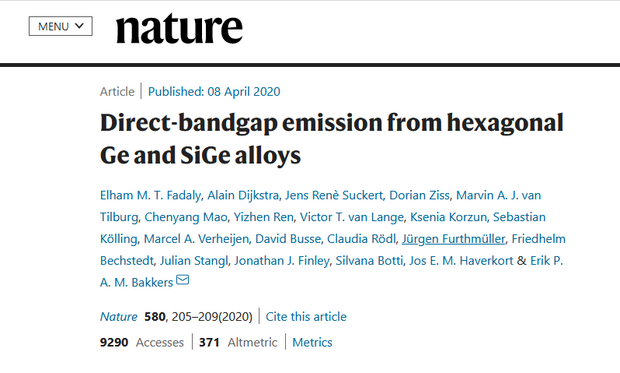
Julian Stangl and Dorian Ziss among authors of
Light Emitting Silicon: Publication in NATURE

Julian Stangl and Dorian Ziss among authors of

Congratulations to Julian Stangl and his group to the publication of their article: “Direct-bandgap emission from hexagonal Ge and SiGe alloys”. This work, recently published in the high-impact journal Nature (April 8, 2020), opens an external URL in a new window, is the result of a multi-national collaboration, lead by scientists from Technical University of Eindhoven (TU/e). Within the FET-Open project SiLAS (SiliconLaser) it has been proven that hexagonal SiGe (realized in core-shell nanowire structures), above a critical germanium concentration (>60%), shows a direct and tuneable bandgap. This allows for the first time efficient light emission from SiGe, potentially revolutionizing the electronics industry by allowing intra-chip and chip-to-chip communication at the speed of light, offering a significantly reduced energy consumption.
Every year we use and produce significantly more data. But our current technology, based on electronic chips, is reaching its ceiling. The limiting factor is heat, resulting from the resistance that the electrons experience when traveling through the copper lines connecting the many transistors on a chip. If we want to continue transferring more and more data every year, we need a new technique that does not produce heat. Bring in photonics, which uses photons (light particles) to transfer data.In contrast to electrons, photons do not experience resistance. As they have no mass or charge, they will scatter less within the material they travel through, and therefore no heat is produced. The energy consumption will therefore be reduced. Moreover, by replacing electrical communication within a chip by optical communication, the speed of on-chip and chip-to-chip communication can be increased by a factor 1000. Data centers would benefit most, with faster data transfer and less energy usage for their cooling system. But these photonic chips will also bring new applications within reach. Think of laser-based radar for self-driving cars and chemical sensors for medical diagnosis or for measuring air and food quality.To use light in chips, you will need a light source; an integrated laser. The main semiconductor material that computer chips are made of is silicon. But bulk silicon is extremely inefficient at emitting light, and so was long thought to play no role in photonics. Thus, scientists turned to more complex semiconductors, such as gallium arsenide and indium phosphide. These are good at emitting light but are more expensive than silicon and are hard to integrate into existing silicon microchips.To create an all-silicon laser, scientists needed to produce a form of silicon that can emit light. That’s exactly what researchers from Eindhoven University of Technology now succeeded in. Together with researchers from the universities of Jena, JKU Linz and Munich, they combined silicon and germanium in a hexagonal structure that is able to emit light. A breakthrough after 50 years of work.
The work received major response from the international scientific-press:
15.04.2020 - Light-emitting hexagonal SiGe promises integrated photonics breakthroughy, opens an external URL in a new window; (optics.org)
10.04.2020 - Direct-bandgap emission achieved from hexagonal Ge and SiGe alloys, opens an external URL in a new window; (semiconductor-today.com)
09.04.2020 - Light-emitting SiGe alloys developed, opens an external URL in a new window; (electronicsweekly.com)
09.04.2020 - SiGe alloys usable in silicon photonics emit light via direct bandgap, opens an external URL in a new window; (laserfocusworld.com)
09.04.2020 - Durchbruch für Photonik-Chips, opens an external URL in a new window; (pro-physik.de)
08.04.2020 - Nanostructured alloys light the way to silicon-based photonics, opens an external URL in a new window; (nature.com)
08.04.2020 - Silicon-based light emitter is ‘Holy Grail’ of microelectronics, say researchers, opens an external URL in a new window; (physicsworld.com)